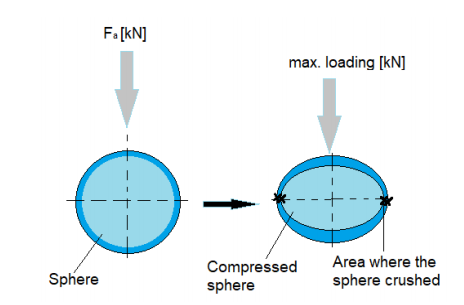Researchers from Romania have studied the mechanical properties of parts fabricated from polylactic acid, releasing the details of their recent study in ‘Mechanical Behavior of 3D Printed PLA Hollow Spherical Parts Under Axial Compression.’
Often used in the construction of bearings and spherical joints, spherical parts usually assist as intermediates in the movement of other components; for example, they may allow rotation to occur or for one part to slide smoothly toward another. Filled spheres tend to be more rigid, while cave spheres are elastic.
Users may employ both metallic and non-metallic materials, and the authors note that ‘plastics present a particular interest.’ In this study, the researchers focused on cave spheres produced from plastic while under compression.
While there are numerous methods for fabrication of parts, additive manufacturing is of interest to the authors in this study—especially in terms of the following results:
- Surface roughness
- Surface layer properties
- Material homogeneity
“In the case of the technological process of manufacturing the spherical parts, some process input factors can influence the surface roughness of the final product,” explain the researchers. “If 3D printing is taken into consideration as a manufacturing solution, then the process seems to be simple enough and of good quality from the surface aspect.
“In practice, there is some important kind of stresses which are convenient for the technical uses of the parts. For example, the compression stress reveals how resistant is a spherical part under a certain force until the part is deformed and loses the properties of being used.”
A hollow sample part was 3D-printed to understand more about typical mechanical properties, along with compression-resistance, and elastic behavior.
“Sometimes there are situations when the elastic behavior under compression axial forces is of technical and functional interest,” said the authors.
The sample was composed in an L9 Taguchi orthogonal design, featuring four different variables for three experimental levels. Nine combinations are considered total with that particular design, revealing the effects of axial compression tests. A simulation was prepared, using the finite element method, offering insight into material behavior before beginning formal research—along with assisting in projections for crack generation.

Simulation using the finite element method of the new shape of the plastic spherical hollow part under the action of the axial compression force (wall thickness h= 2 mm, axial force max. Fa=7.189,97 daN)
The test sample was printed with silver metallic PLA on an Ultimaker 2+, with no finishing permitted after fabrication—lest new elements introduced into the part could affect compression testing.
“One could remark the similarities between the plastic spherical hollow parts behaviors simulated employing the finite element method and the real behavior proved by the experimental testing; this means that the considerations formulated when theoretically analyzing the deformation conditions of the spherical parts were correct,” concluded the authors.
“The analysis of the model showed that the maximum influence on the elasticity of the parts was exerted by the printing plate temperature. As expected, the increase of the part wall thickness determines an increase of the plastic spherical part elasticity. In the future, extended experiments could be developed, to evaluate the effect exerted also by other manufacturing process input factors on the behavior of the parts under axial compression efforts.”
Researchers continue to find better ways to predict and improve mechanical properties, studying other influences like color, porosity, and more. What do you think of this news? Let us know your thoughts! Join the discussion of this and other 3D printing topics at 3DPrintBoard.com.
[Source / Images: ‘Mechanical Behavior of 3D Printed PLA Hollow Spherical Parts Under Axial Compression’]
Subscribe to Our Email Newsletter
Stay up-to-date on all the latest news from the 3D printing industry and receive information and offers from third party vendors.
You May Also Like
3D Printing Financials: Fathom Struggles in Financial Quicksand During Critical Transition
Facing a year of key transitions and financial pressures, Fathom (Nasdaq: FTHM) has filed its annual report for 2023 with the U.S. Securities and Exchange Commission (SEC). The document outlines...
Latest Earnings Overview for Australian 3D Printing Firms Titomic and AML3D
Australian 3D printing manufacturing firms Titomic (ASX: TTT) and AML3D (ASX: AL3) reported their financial results for the period from July to December 2023, marking the first half of their...
3D Printing Webinar and Event Roundup: April 7, 2024
Webinars and events in the 3D printing industry are picking back up this week! Sea-Air-Space is coming to Maryland, and SAE International is sponsoring a 3D Systems webinar about 3D...
3D Printing Financials: Unpacking Farsoon and BLT’s 2023 Performance
In the Chinese 3D printing industry, two companies, Farsoon (SHA: 688433) and Bright Laser Technologies, or BLT (SHA: 688333), have recently unveiled their full-year earnings for 2023. Farsoon reported increases...


































